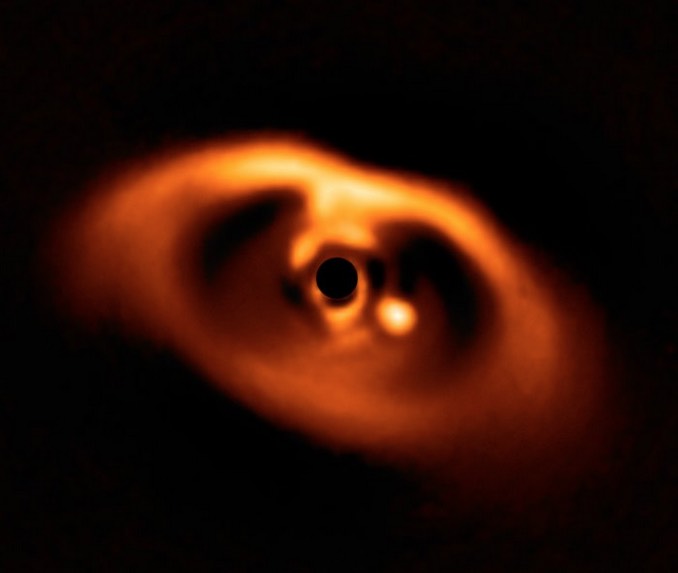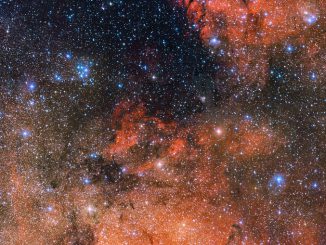
Astronomers using the SPHERE instrument on the European Southern Observatory’s Very Large Telescope have made the first “robust” detection of an infant planet – PDS 70b – in the process of forming as it plows through a dusty disc around a hot, young dwarf star.
Researchers also were able to measure the brightness of the planet at different wavelengths, determining it to be a gas giant a few times more massive than Jupiter with a cloudy atmosphere and a surface temperature around 1,000 C (1,800 F), hotter than any planet in Earth’s solar system. The planet circles its parent star, PDS 70, at a distance of about 3.3 billion kilometres (2 billion miles), taking 120 years to complete one orbit.
PDS 70 is a youngster itself, a 4.5-million-year-old T Tauri star surrounded by a circumstellar disc of gas and dust about 130 astronomical units across, or about 19 billion kilometres (12 billion miles).
In a remarkable image, the young planet is clearly visible, standing out as a distinctive bright spot just to the right of PDS 70, which is blocked out by a mask. Without the mask, or coronagraph, the star’s light would overwhelm the light from the planet.
“These discs around young stars are the birthplaces of planets, but so far only a handful of observations have detected hints of baby planets in them,” said Miriam Keppler, leader of a team representing the Max Planck Institute for Astronomy that discovered the still-forming planet. “The problem is that until now, most of these planet candidates could just have been features in the disc.”
A second Max Planck team led by André Müller used SPHERE to capture the image of PDS 70b. SPHERE was designed to study exoplanets and proto-planetary discs using a technique known as high-contrast imaging to filter out the planet’s light from the glare of its star. But even using a coronagraph, a variety of imaging and data processing techniques are required to detect the signal from a relatively faint planetary companion.
The proto-planetary disc and PDS 70b were studied over the course of two survey programmes, one aimed at imaging 600 young nearby stars in the near-infrared using high-contrast and high-angular resolution and another focused on studying known circumstellar disks to learn more about the initial conditions of planetary formation.
“For our study, we selected PDS 70, a star that was already suspected of having a young planet circling around it,” said Keppler, a Max Planck doctoral student.
As it turns out, the planet orbiting PDS 70 has carved out a so-called transition disk, that is, a proto-planetary disc with one or more gaps where planets are in the process of forming. Such features were known previously, but this is the first time the planet causing one has been directly detected.
“Keppler’s results give us a new window onto the complex and poorly-understood early stages of planetary evolution,” said Müller. “We needed to observe a planet in a young star’s disc to really understand the processes behind planet formation.”



